A boy from a good family. A trusting PE player. A rich and respected host. At first glance, there was nothing to connect them with the hideous murders that shocked the public opinion of the People's Republic of Poland. And yet it was they who turned out to be real beasts in human skin, capable of unimaginable cruelty.
How many murders were committed in the Polish People's Republic? Looking at the statistics from the 1950s, it can be concluded that there were many of them. The record year of 1951 brought 1,149 victims of murder, and in this decade there were never fewer than 680 of them. It took 50 years for these infamous numbers to change - it did not improve until 2001.
Reports about the achievements of the most brutal killers rarely found their way to the press. The militia preferred to "protect" the public from such information. She also did not want to look inept. However, stories of dismembered women, children killed in broad daylight, and people run over in cars on Christmas Eve have finally come to light. And more than once they caused a real panic among people.
The Butcher from Niebuszewo
Józef Cyppek was called a butcher for a reason. He managed to prove only one murder, committed on Irena Jarosz. The very description of what was discovered in his house in Szczecin, however, explains why he is at the forefront of the ranking of the cruelest murderers of the Polish People's Republic. The case file noted:
There was a woman's corpse on the couch in the room on the couch, with her head, arms, legs and guts stretched out . Hands and one thigh against the wardrobe. Guts - in a bucket under the window. In the kitchen, red stains on the sink, chairs and door - some ineptly rubbed.
On the shelf next to the tiled kitchen, a bowl half full of red liquid. Next to it is a meat grinder with traces of grinding. On the plates of the heart and the human liver . Uneaten scrambled eggs with some fat on the table, in a frying pan. Next to it there is bread with lard, tomato salad and a piece of raw meat, probably beef. There were bottles of beer and vodka all over the apartment.
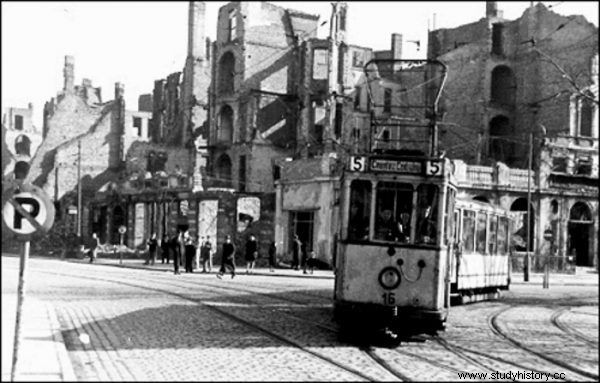
Post-war Szczecin was a difficult place to live in. The photo shows the war damage in 1948 (photo by Andriusza - pomeranica.pl, license CC BY-SA 3.0)
The description of the dismembered body agrees with what can be seen in the photo, which is still circulating on the Internet today and which should not be seen by the faint of heart. The drawing showing where Cyppek made precise cuts is also easy to find.
Although the body was missing its head, Mrs. Jarosz's husband managed to recognize it. The cause of death was also established. The murderer himself admitted that he beat the woman with a hammer. He fell into a rage because the beautiful, only 20-year-old Irena came to him to borrow a glass of flour and did not want to repay it with sex . Why did the torturer dismember the body? He did it to make it easier to get rid of. And so the head ended up in the nearby Rusałka Lake, while the arms, legs and the rest were waiting for their turn.
The human imagination, especially when driven by descriptions full of brutal details, knows no bounds. The inhabitants of Szczecin soon began to suspect that Irena Jarosz was not the only victim of Cyppek. It was even speculated that he was actually murdering and then selling human flesh to his butcher's friends. Regardless of the truth, the criminal was put on the gallows on November 3, 1952 - after a swift, one-day trial.
Last sleigh trip
In the 60s of the last century, Krakow froze in terror, constantly learning about the next victims of the unknown cutthroat. Nobody imagined that Karol Kot, a young boy from a good family, might be sought.
When the perpetrator attacked the old ladies, the panic was still moderate. In 1966, however, he killed a child and people went mad with anxiety, and a pale fear fell on the city. In the book "M jak killer. Karol Kot - a vampire from Krakow ”Przemysław Semczuk recalls the Polish Radio announcement on this subject:
On February 13 this year, Krakow's public opinion was shocked by an unusual accident:a minor boy, Leszek Calek, was killed with a knife at the Kościuszko Mound. Despite the greatest efforts of the security authorities, it was not possible to find the perpetrator for a long time.
A lot of people attended the boy's funeral, which was a kind of demonstration against the ineptitude of the militia. "Thousands of people bid farewell to an innocent victim of a hideous murder forever" - wrote "Dziennik Polski".
When Karol Kot was finally caught, during an on-site visit he told exactly how he had committed this terrifying and senseless crime. He admitted that just wanted to murder someone . He had been planning this for several days, but had not assumed that a child would be his victim. Leszek seemed to him "the right object".
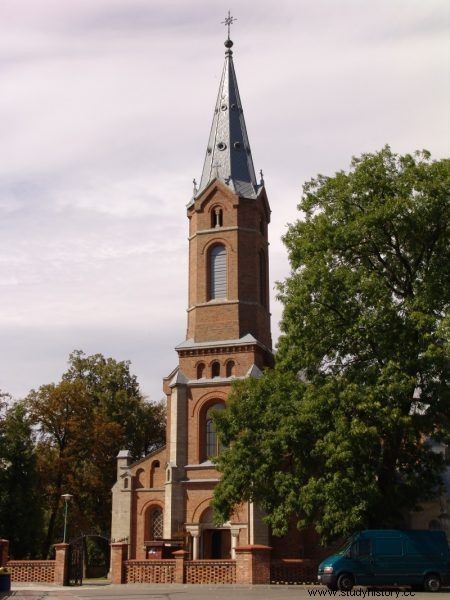
Połaniec, the parish church of st. Martin. It was after his departure that the nightmare of the victims of the Połaniec massacre began (photo:Kamil272, license CCA SA 3.0 PL)
First, he asked the boy if there was a tobogganing competition or a Spartakiad taking place on the Mound. The latter turned his head to reply to his future torturer. He was still holding the sledge in his hand. The knife pulled him towards him and, standing in the back, struck him 11 blows with a tool he called "the bayonet". It was more than enough - after about 4-5 blows, the child was inert. As the murderer himself put it:"he has already flew through his hands."
Ultimately, the young man was sentenced to death for 2 murders, 10 attempted murders (including an attack on a 7-year-old girl) and arson. The punishment was carried out on May 16, 1968.
In the silence of the night
The so-called Połaniecka case is one of the loudest and, at the same time, the most brutal massacres of the Polish People's Republic. The tragic event took place on the night of December 24-25, 1976 on the road from Połaniec to the village of Zrębin (today's Świętokrzyskie Province).
The cause of the crime was more than trivial. Well, in August of the same year, the wedding of two of the victims - Krystyna Kalita and Stanisław Łukaszek - took place. At that time, Jan Sojda's sister, Adasi, was employed to work in the kitchen. The woman was promised that after the party she would be able to take a fixed amount of food for herself. However, when the hosts noticed that she was trying to take large amounts of cold cuts (more than agreed), they called her attention. The cook rose with honor, and her brother swore revenge.
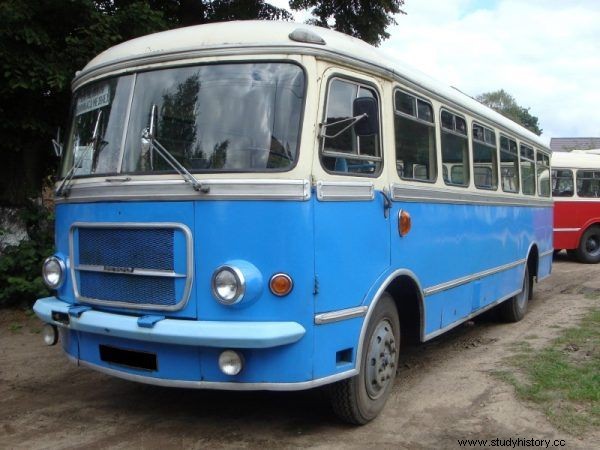
A blue SAN bus was parked next to the church in Połaniec. The photo shows San H100A (photo:Travelarz, license of CCA SA 3.0)
On the memorable Christmas Eve of 1976, the inhabitants of Zrebin, several dozen people in total, went to the mass in Połaniec by two buses specially hired for this occasion. There was an additional attraction waiting for them - in the blue Sana standing near the temple, everyone, headed by Sojda and the village leader, took part in an alcoholic libation. Meanwhile, pregnant Krystyna Kalita (now Łukaszek) and her husband were tricked out of the mass. The woman was told that her father was very drunk and was "making trouble" at home. The couple, accompanied by Krystyna's brother, Mietek, walked home.
The three innocent people were soon caught up by the blue San. It was driven not only by the vengeful Sojda, but also by drunk villagers. The "escort" was a Fiat 125p and it was he who ran over the teenage Mietek. None of the people on the bus reacted. When Krystyna and Stanisław ran up to the wounded boy, they were attacked by Jan Sojda and his brother-in-law with a wrench to the bus wheels. Then, as the indictment later stated, the main perpetrator and his supporters decided that:
(...) should be done in such a way that it follows that the death of Krystyna and Stanisław Łukaszek and Krystyna's brother, Mieczysław Kalita, was a consequence of a road accident, and to pretend that Krystyna was left raped before her death. So the bodies of Stanisław and Mieczysław were taken out, as well as the still unconscious Krystyna, who was placed in a ditch on the right side of the road, head towards Połaniec.
The bodies of Stanisław and Mieczysław were moved some distance from Krystyna, placing them in a ditch. The driver's place on the San bus was taken by Bronisław Karaś, who drove into the ditch, running into the corpse. Then backed the bus along the bottom of the ditch, driving the rear wheel over lying Krystyna . As a result, she suffered pelvic fractures and brain injuries, which directly resulted in her death. (…).
The effects of the mock accident were terrible. All victims had extensive fractures of the skull bones. In the case of Stanisław, the bone was dented, damaging the brain. Mieczysław's injuries were described as "crushing and bruising of the brain tissue".
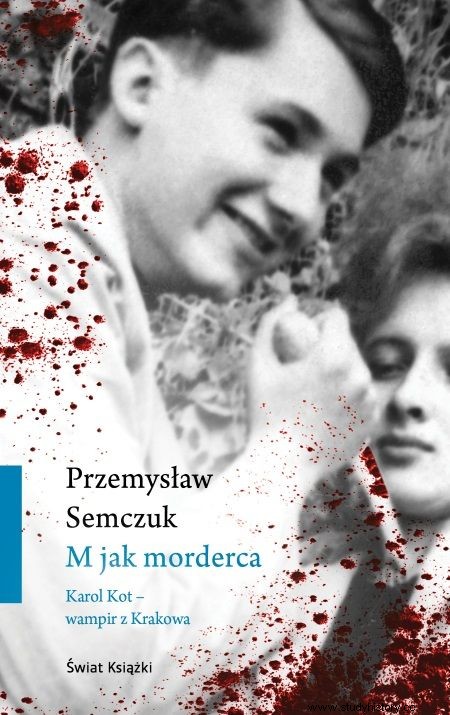
The article was inspired by the book by Przemysław Semczuk “M jak morderca. Karol Kot - a vampire from Kraków ”, which was published by the Świat Książki publishing house.
To avoid punishment, Jan Sojda urged his fellow residents to silence. He was highly respected in Zrebin, so the witnesses sworn that they would never confess the truth. Nevertheless, the guilty were punished. Sojda and his brother-in-law Józef Adaś, who had been found complicit, were sentenced to death. The sentences were carried out in 1982 in the Kraków detention center at Montelupich Street. Two other torturers were imprisoned for many years.
Sacrifice of Satan from Piotrków
Mariusz Trynkiewicz became famous in 2014, when he was ending his prison sentence for the heinous crimes committed in the late 1980s. People trembled at the thought that it would be easy to walk the streets again, also near innocent children.
This murderer and pedophile killed a total of four boys. First, he lured one of them to him, and then another three. He knew perfectly well how to talk to children in such a way that they would trust him. He was a teacher and had experience in working with young people.
At the end of hot July 1988, Trynkiewicz was only 26 years old. In search of victims, he went to the Bugaj reservoir in his hometown of Piotrków Trybunalski. It was full of minors, and he was just waiting for such an opportunity. He chose three boys from the group of children. He invited them home, promising to show them his postage stamps, an aquarium with fish and teach them how to shoot with an air rifle. It inspired the trust of 11-year-old Tomek and two 12-year-olds:Krzys and Artur.
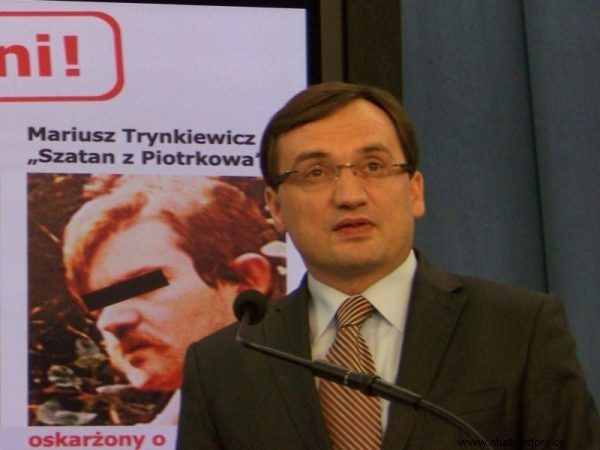
Zbigniew Ziobro at a press conference in 2012. In the background, the image of Mariusz Trynkiewicz (photo:Patryk Matyjaszczyk, license CC BY-SA 3.0) `
When they got there, he stabbed the boys, then washed their bodies and carried them to the basement. Later he took them to the forest, where they were found by a random mushroom picker. The children were tied with a rope, wrapped in cloth and, as it turned out, burned. The psychopathic killer tried to cover his tracks in this way . Trynkiewicz was quickly captured. He did not remember much, but his testimony is still terrifying. This is how Ewa Żarska, the author of the book devoted to the criminal, reports:
He fogs up seeing the boys lying in the room. Blood was leaking from their mouths. They were all bloody. He remembers putting plastic bags over their heads . “I think I was in the bathroom and was throwing up. I remember taking something out of the sheets, it must have been sheets. I even took out some of the pillowcase from the suitcase on the couch. I do not remember the moment and method of packing the corpse. I remember looking at my watch, it was 5 pm I left the apartment when I left the bathroom ".
The investigation revealed that the boys were not the first victims of a pedophile PE . Earlier, on July 4, he raped and killed 13-year-old Wojtek. The child was strangled and then buried in the forest. Currently, the murderer is in a psychiatric center for particularly dangerous criminals in Gostynin. This did not prevent him from getting married. Had it not been for the amnesty, he would have been dead for a long time.
Every now and then there is a revival in Poland about the death penalty. Many believe that the most brutal murderers, who are guilty of no doubt, should be removed from society forever. Most of the "heroes" of this article faced such an end, which was the fulfillment not only of the court sentence, but also the will of the outraged society.
